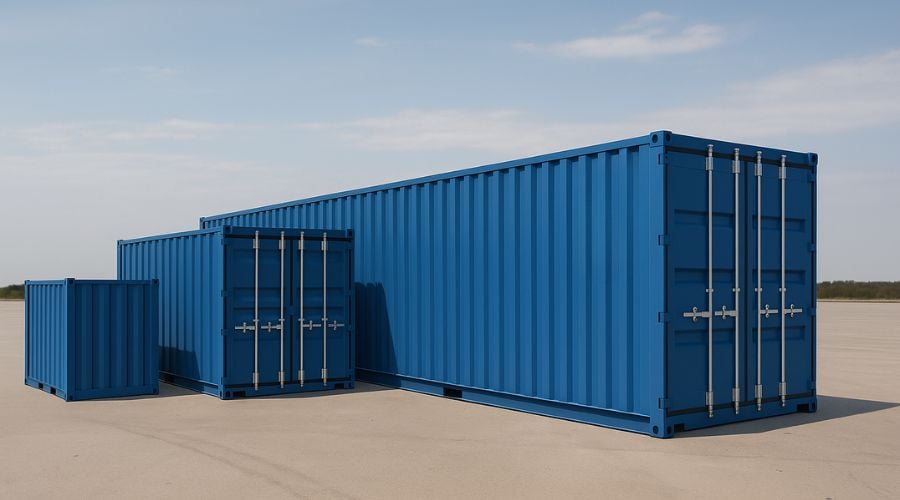Looking to buy or rent a shipping container, but not sure what size you need? No worries, we’re here to help!
At first, it seems simple: you need a shipping container. But then you realize there’s more than one size. And not just size, there are different types, dimensions, and use cases, too. So, how do you know which one’s right?
Whether you’re storing items, shipping goods, or prepping for seasonal overflow, this guide breaks down the most common container sizes, what they’re best used for, and how to choose the one that fits your needs.
Shipping Container Sizes
Before diving into all the specs and comparisons, it helps to see how the most common shipping container sizes stack up side by side. The visual below gives you a clear look at four standard container types, from compact 10 ft options to full-size 40 ft high cubes. Use it as a quick reference to understand how each size differs in length and height, so you can better picture what might work for your space and storage needs.
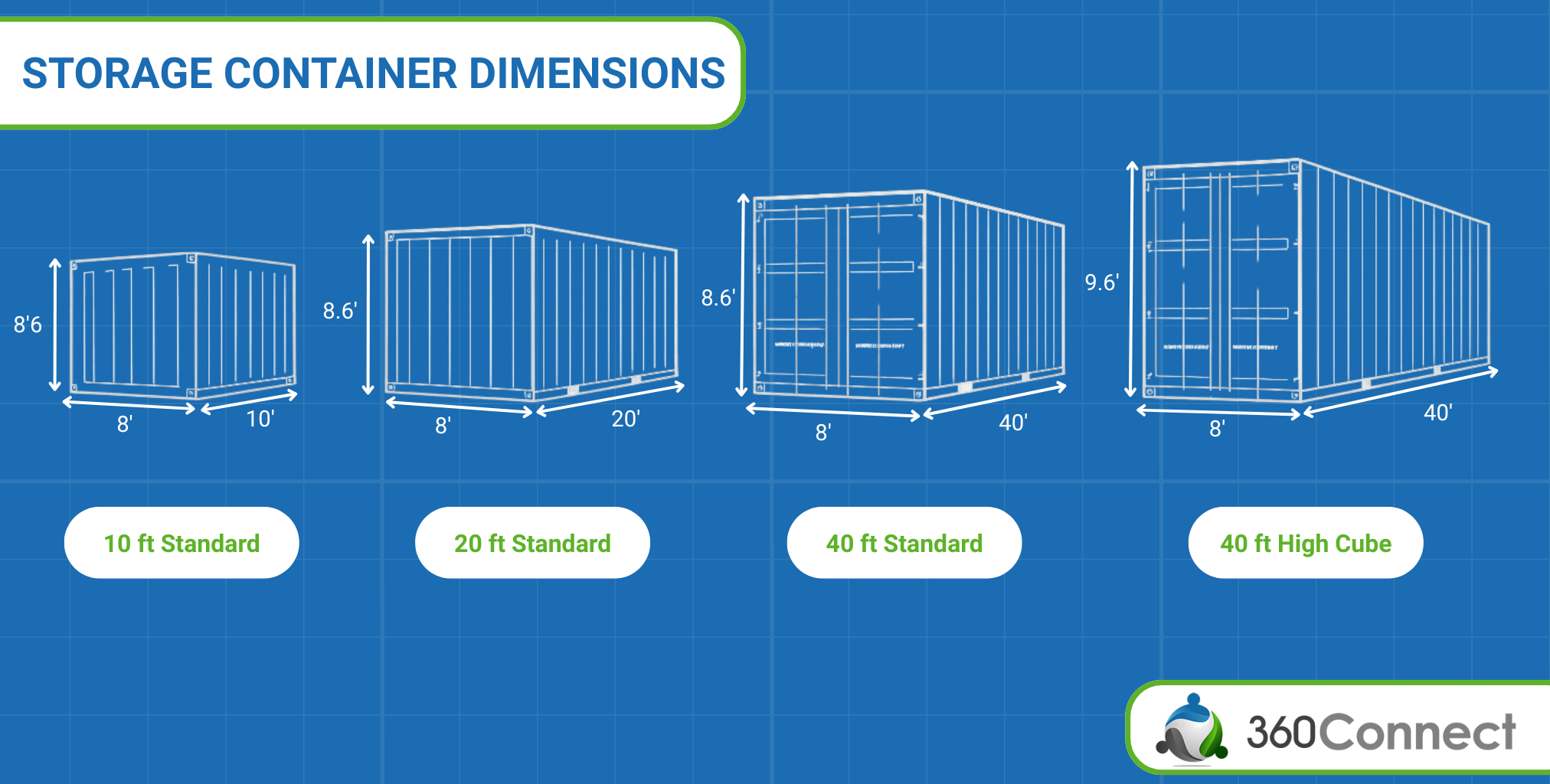
Shipping Container Size Guide
Now that you’ve seen how each container stacks up visually, let’s go a step further.
It’s one thing to see the difference in length and height, but understanding what those differences mean for storage, transport, and usability is where it really counts. That’s where this guide comes in.
Start with the chart below for a quick side-by-side comparison of key specs. Then, scroll through the full breakdown of each container size to get a better idea of which one fits your space, your goals, and your day-to-day use.
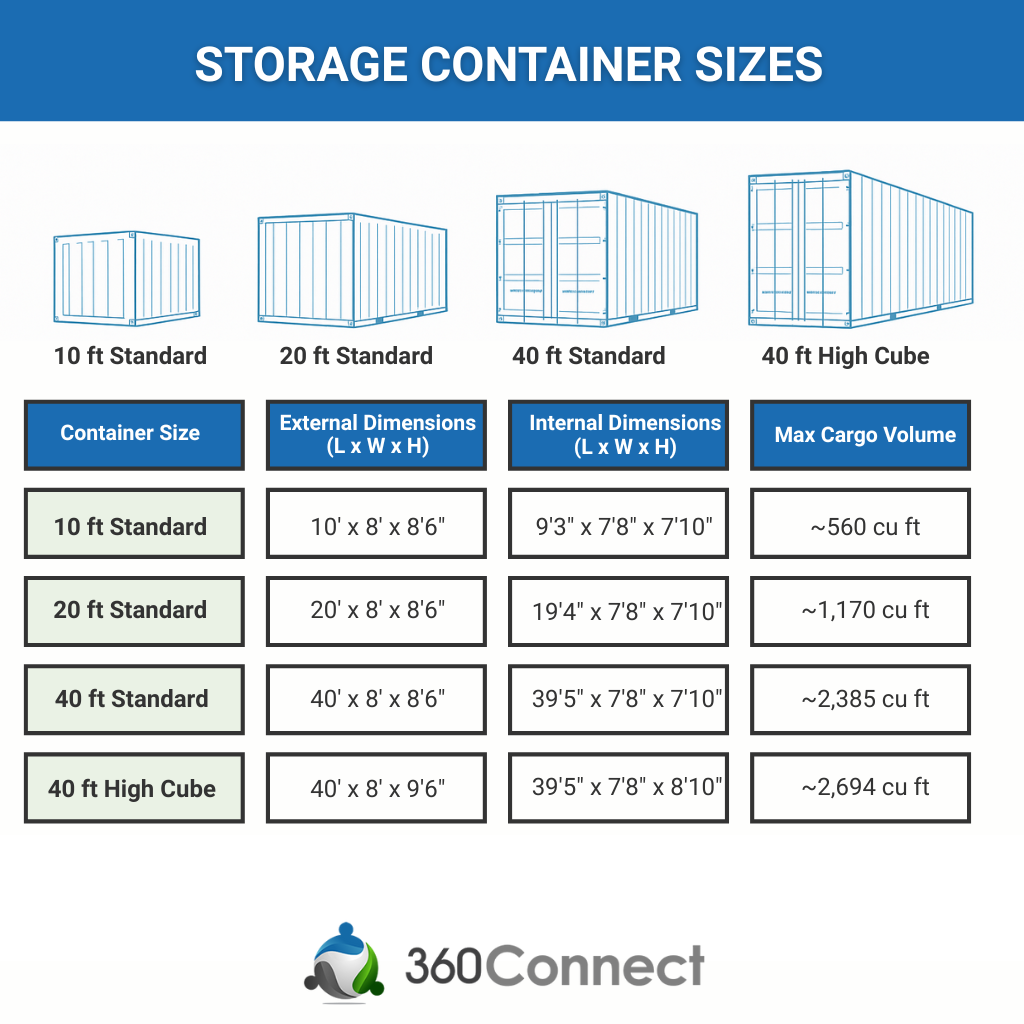
10 ft Storage Container
Compact and maneuverable, the 10 ft container is ideal for small-scale needs. You’ll often find these used for residential renovations, secure storage on tight job sites, or extra space for small businesses with limited room to spare.
These containers are easy to tuck into alleys, behind shops, or on smaller lots. Despite their size, they still offer a reliable solution for weatherproof and secure storage.

- External: 10′ L x 8′ W x 8’6″ H
- Internal: 9no’3″ L x 7’8″ W x 7’10” H
- Use Case: Temporary storage, mobile offices, retail overstock, residential or urban applications.
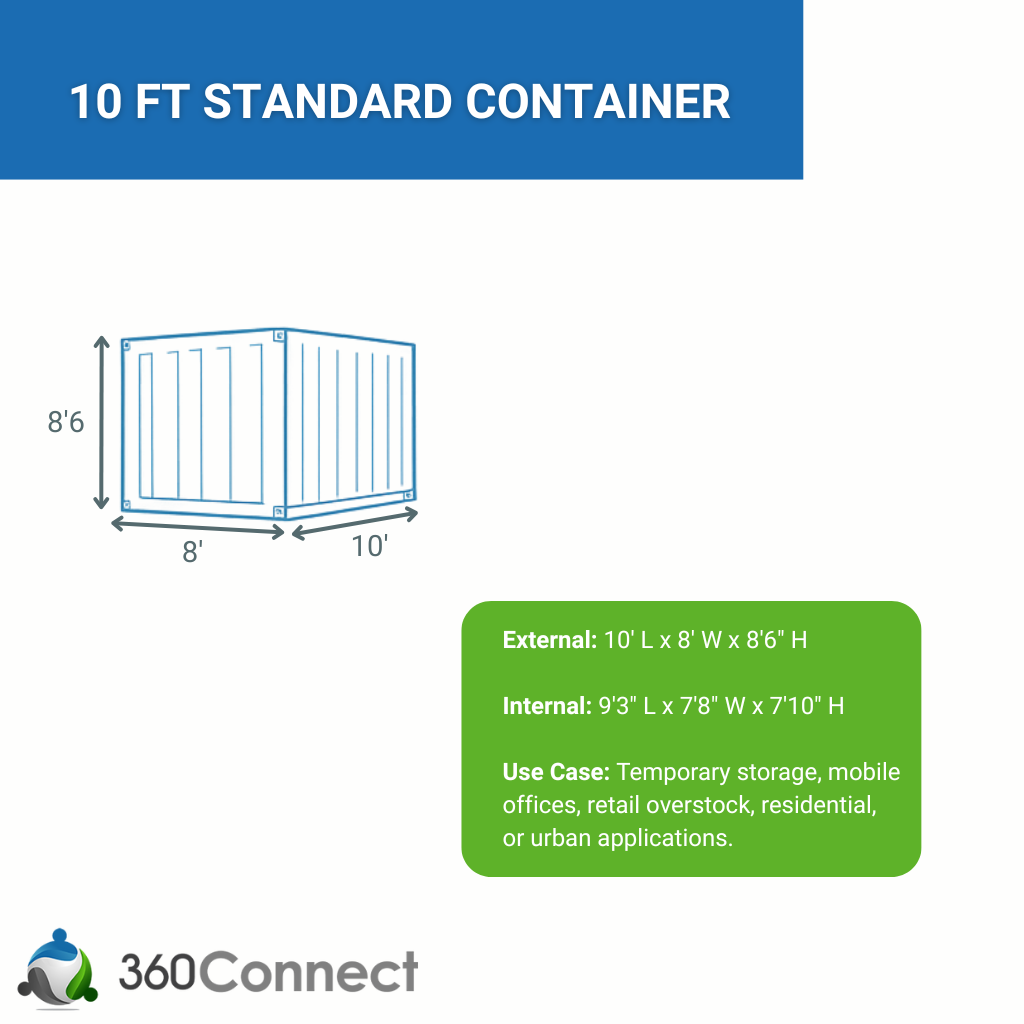
20 ft Storage Container
This is the workhorse of the shipping container world. The 20 ft container strikes a perfect balance between capacity and mobility, making it a favorite for construction sites, retail storage, small-scale shipping, and event organizers.
It fits easily in a standard parking space and is easier to deliver in tight areas compared to a 40 ft container.
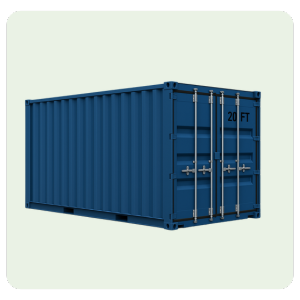
- External: 20′ L x 8′ W x 8’6″ H
- Internal: 19’4″ L x 7’8″ W x 7’10” H
- Use Case: Jobsite tools, mid-volume shipping, seasonal inventory, pop-up retail builds, and modular construction projects.
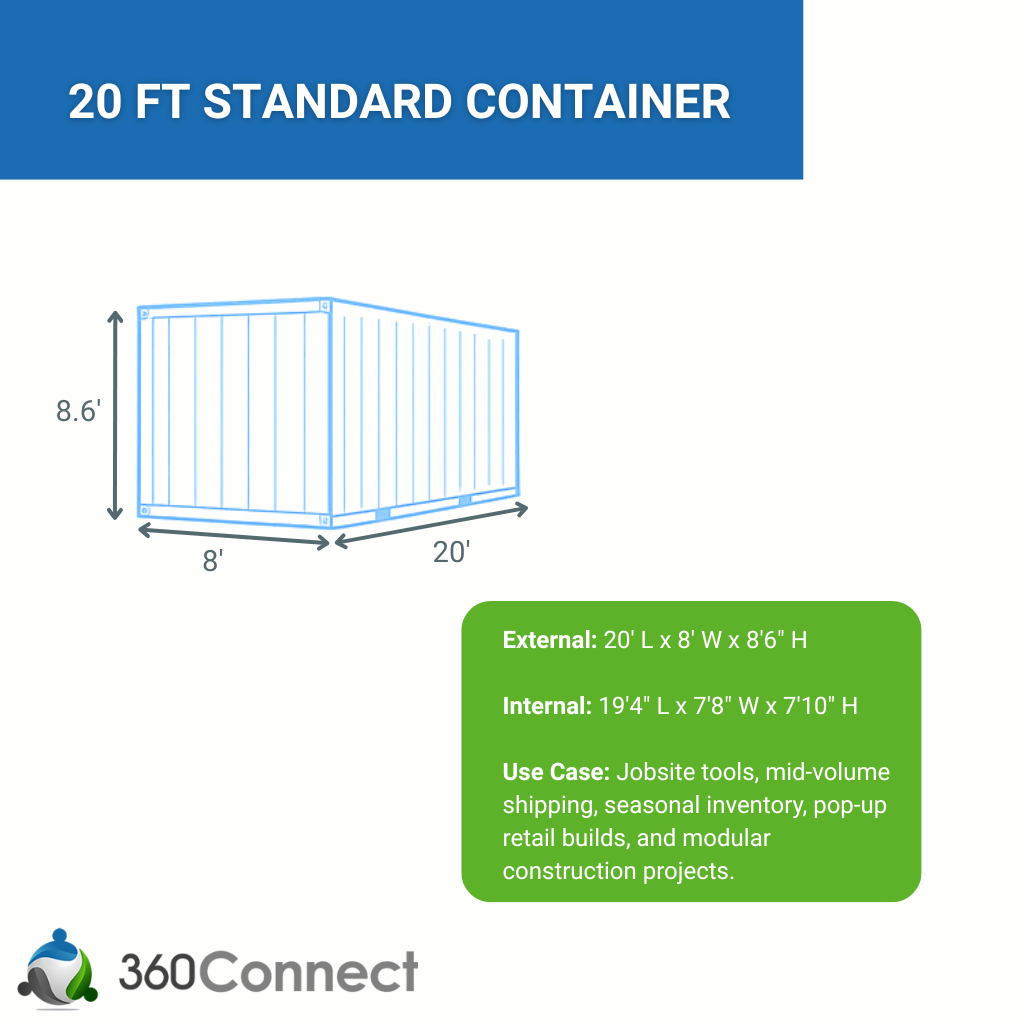
40 ft Storage Container
Best suited for bulk shipping, warehouse backup, or industrial-scale storage. This is a favorite for international freight due to its efficiency per cubic foot. If your operations involve mass shipping or long-term static storage, a 40-footer ensures you’re not constantly making room.
The 40-foot unit is the most space-efficient standard container on the market. It’s ideal for long-term storage, large shipments, and major facility expansions. These containers are often seen in industrial parks, at ports, and in rural areas used for bulk storage or workshops.
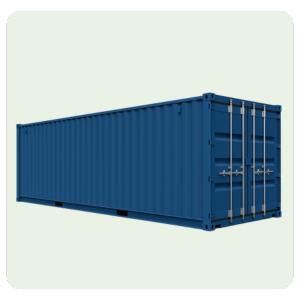
- External: 40′ L x 8′ W x 8’6″ H
- Internal: 39’5″ L x 7’8″ W x 7’10” H
- Use Case: Commercial shipping, warehouse backup, modified office spaces, and bulk materials. They can also be customized with roll-up doors, ventilation, and insulation for extended-use purposes.
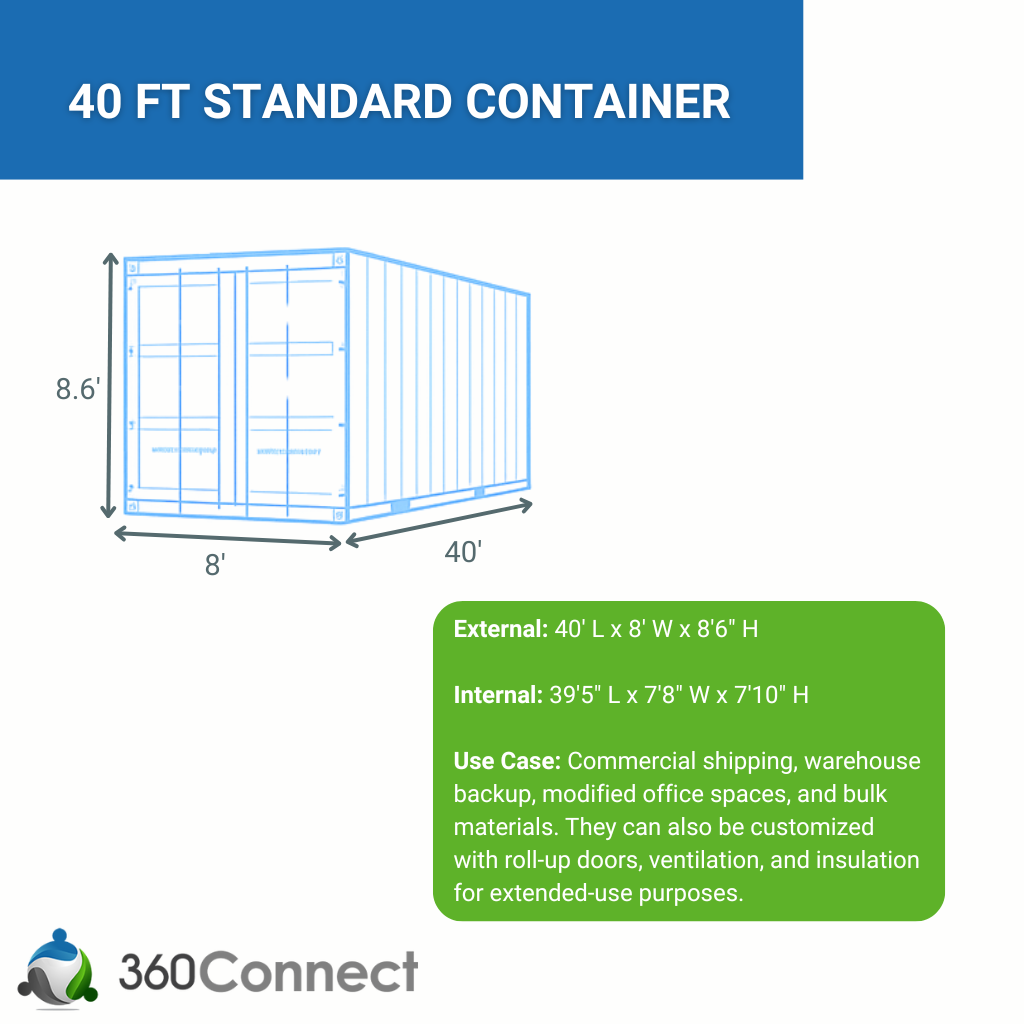
40 ft High Cube Storage Container
Need more vertical space? A 40 ft high cube container adds an extra foot of height, giving you more room for stacking pallets, storing tall equipment, or building out insulated interiors.
Because of that added headroom, high cubes are especially popular for custom builds, including tiny homes, modular workspaces, and mobile showrooms.
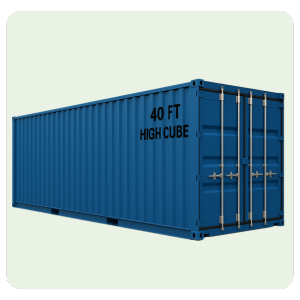
- External: 40′ L x 8′ W x 9’6″ H
- Internal: 39’5″ L x 7’8″ W x 8’10” H
- Use Case: Tall inventory, furniture storage, racking systems, container builds, or conversions requiring interior insulation and ductwork.
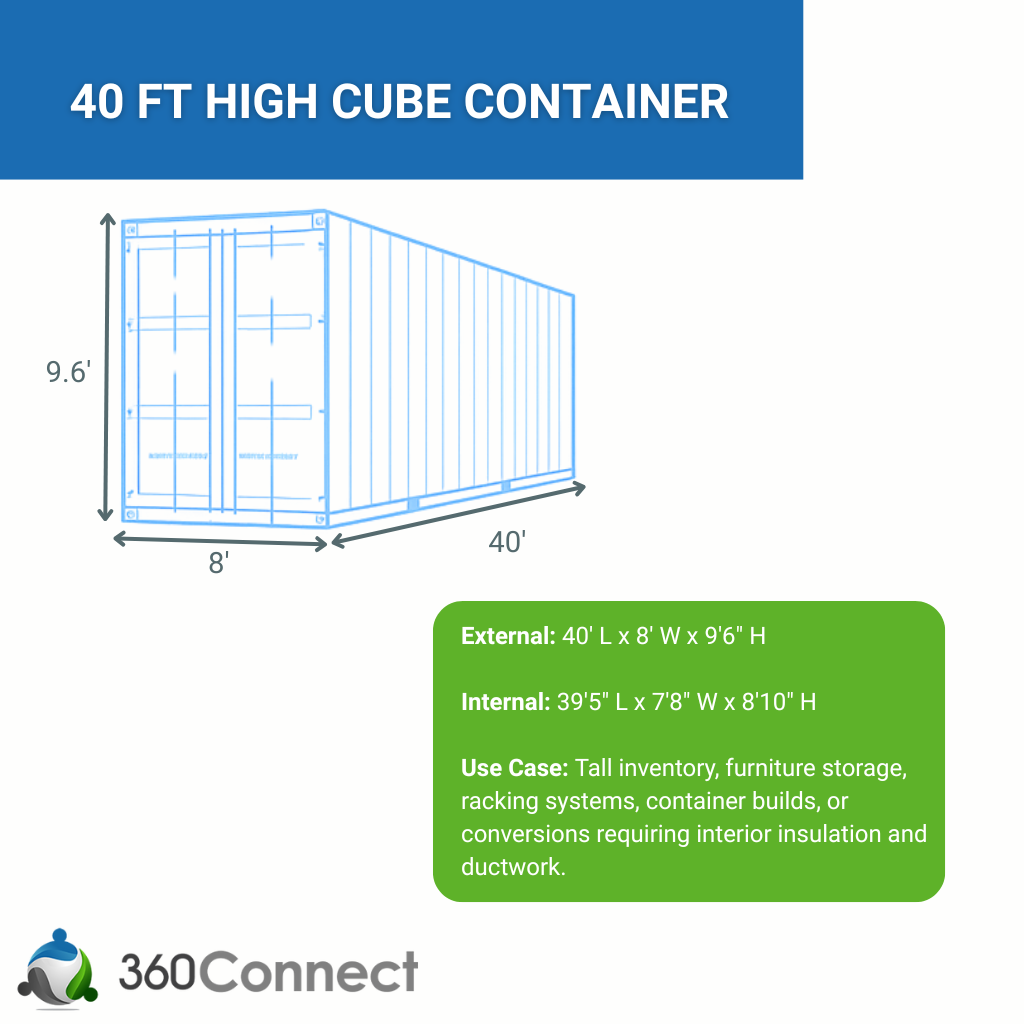
Most Common Shipping Container Sizes
So, from the shipping container size guide above, which sizes are the most common?
Hands down: the 20 ft and 40 ft containers.
These two dominate the market for good reason:
- The 20 ft container is easy to move, fits in smaller spaces, and offers just enough storage for tools, inventory, or short-term projects without being overkill.
- The 40 ft container gives you serious space, ideal for long-haul shipping, high-volume storage, or modified builds that need room to grow.
Whether you’re looking to buy or rent, these two sizes are the most versatile, widely available, and cost-effective options in most situations. We’ll help you compare them further below so you can confidently choose the one that fits your space and goals.
Compare Shipping Container Sizes (20 vs 40)
If you’re stuck between the two most popular sizes, this section can help you compare these options side by side. A quick look at their features can reveal a lot about what fits your situation best.
| Feature | 20 ft Standard | 40 ft Standard | 40 ft High Cube |
| Volume | ~1,170 cu ft | ~2,385 cu ft | ~2,694 cu ft |
| Payload | ~48,000 lbs | ~58,000 lbs | ~58,000 lbs |
| Best for | Medium jobsites | Large-scale operations | Tall item storage |
The decision often boils down to your balance between space and cost. A 20ft vs 40ft container comparison might seem like a size issue, but it’s really about logistics and planning.
For example:
- A 20ft container is easier and cheaper to transport, making it great for temporary projects or limited delivery access areas.
- A 40ft container offers double the space without doubling the delivery cost, a better value if you can accommodate the size.
- A high cube container gives you vertical flexibility. If you’re stacking boxes, storing tall inventory, or modifying it into a livable or usable space, the extra height is a game-changer.
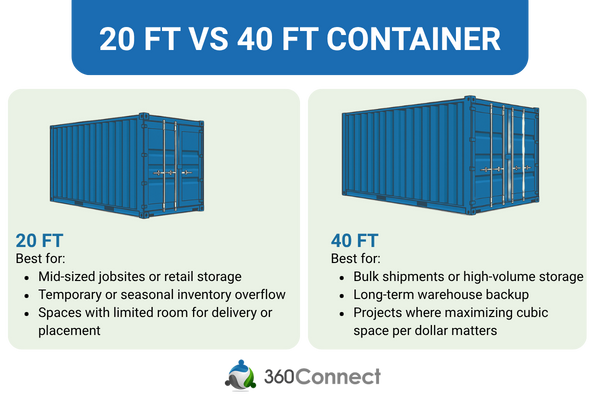
Think about:
- Storage method: Will you stack vertically or spread items on the floor?
- Site accessibility: Do you have enough turning space and room for delivery?
- Container modification: Are you adding windows, doors, HVAC systems, or shelving?
- Delivery cost: It may be more economical to get a larger container delivered once than multiple smaller units.
By walking through these points, you can better evaluate your container not just by size, but by usability and practicality.
Do Features Change the Container Size You Need?
Yes — the features you need can absolutely influence which container size is right for you.
For instance, dry containers account for over 80% of the global market thanks to their versatility in storing general cargo, which means most buyers default to standard 20 ft or 40 ft sizes. But if you’re storing temperature-sensitive goods like food, flowers, or pharmaceuticals, you’ll likely need a reefer container (short for refrigerated container).
These insulated units come with built-in cooling systems, which take up internal space. So while a reefer may be labeled as 20 ft or 40 ft, the usable space inside is slightly less than a standard dry container. If you’re leaning toward a reefer, it’s smart to size up or double-check the internal dimensions before placing your order.
Related: Refrigerated Shipping Container Sizes: What You Need to Know
Other container modifications that may affect usable space include:
- Interior insulation
- Ventilation systems
- Electrical or plumbing installations
- Shelving or racking
All these features can reduce the interior volume and might require a larger container than originally planned. If you’re working with a modified or specialty unit, consider both the external size and how internal features will impact what you can realistically store.
What About Container Types?
This guide focuses specifically on container sizes, helping you understand the difference between 10 ft, 20 ft, 40 ft, and high cube options so you can choose the right fit for your space and needs.
But size is just one part of the equation.
There are also different types of containers, like:
- Reefer containers (refrigerated)
- Open-top containers
- Double-door containers
- Modified storage units
If you’re interested in learning more about container types, read more here.
How to Choose the Right Shipping Container Size
With so many sizes and features available, it’s easy to feel unsure about what to choose. But don’t worry, figuring out what container size you actually need comes down to a few practical questions. Let’s walk through the key factors to help you confidently make the right call.
- Know your purpose: Will you be storing seasonal inventory, tools, equipment, furniture, or using the container for a build (like a container office or home)? Commercial, residential, and industrial users all have different container needs.
- Estimate your volume needs: If you’re unsure, try boxing or measuring a sample of what you plan to store. Multiply that by the number of items to get a rough cubic footage estimate. Remember, internal container space isn’t 100% usable due to irregularly shaped items and space for maneuvering.
- Check site access: A 40-foot container needs more clearance and turning radius. If you’re working in a residential area or tight jobsite, a 20-footer may be more practical. Also, some urban or HOA-regulated areas limit the length of time or size of containers allowed.
- Account for future needs: It’s tempting to buy for today, but containers last decades. If you anticipate growth or additional items, going up a size could save time and money down the road.
- Evaluate your budget: Larger containers cost more, both to buy and to deliver, but they often provide a better cost per cubic foot. Ask for a delivery + setup quote when comparing options. And if purchasing isn’t ideal, consider renting for seasonal or short-term projects.
- Consider custom modifications: Do you plan to outfit your container with lighting, insulation, or shelving? High cube containers give you more interior headroom for those additions. Think ahead about layout and usability if your container is more than a simple storage unit.
Still unsure? Speak to a supplier who can walk through the details with you. A reputable provider can advise on container condition (new vs. used), delivery logistics, terrain requirements, buying vs renting, and best practices based on your unique needs.
Final Thoughts
There’s no one-size-fits-all answer when it comes to shipping containers. From small 10-foot units to towering 40-foot high cubes, your choice should reflect your needs today and a little into the future. Think about how you’ll use it, where it will go, and how your needs may change over time.
Choosing the right size is about more than just volume; it’s about efficiency, practicality, and long-term value. Hopefully, this chart and guide helped make your decision a little easier and more informed.
Get Storage Container Quotes Now
If you’re ready to find the right shipping container for your business, we’ve got you covered. At 360Connect, we connect you with reputable storage container suppliers that offer a wide range of sizes, types, and customization options, so you can compare and choose what works best for your needs.
Tell us what you’re looking for, and get matched with up to 5 top suppliers ready to send you free, no-obligation quotes.

